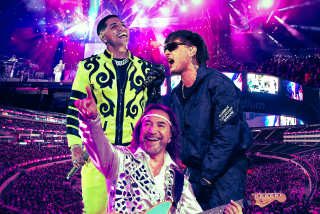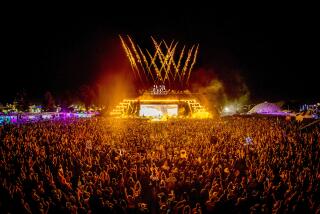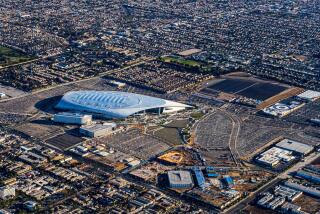Raves leave L.A. for the suburbs, but deaths and drug problems continue
The heart of Los Angeles was once home to some of Southern California’s most memorable rave concerts.
But the geographic center of the scene is rapidly moving east as the popularity of the concerts increases and concerns about drug abuse by ravegoers has sparked a backlash in Los Angeles County.
All of the region’s biggest electronic dance music festivals are now held deep in the suburbs and exurbs of Southern California, centered in San Bernardino County. There, the rave scene has been largely welcomed by government officials and local businesses hoping for an economic boost from the large crowds.
But many of the problems that dogged the concert in L.A. — rampant drug use, overdose deaths and overwhelmed emergency rooms — have persisted.
Over the weekend, three young concertgoers at the Hard Summer concert in Fontana were stricken and later died.
The deaths have heightened debate about what more local governments can do to regulate raves.
“This is extremely disturbing,” said L.A. County Supervisor Michael D. Antonovich. “This unfortunate incident demonstrates that proactive measures must be taken to save lives.”
Hard offers a window into how the rave concert business has changed. The rave began about nine years ago as a relatively small event held in downtown Los Angeles.
Hard Summer has been making the move eastward after it was acquired by entertainment powerhouse Live Nation in 2012. In 2014, the event moved to the Whittier Narrows Recreation Area, where a 19-year-old woman fatally overdosed on Ecstasy. Last year, it was held at the Los Angeles County fairgrounds in Pomona, where two college students, ages 18 and 19, fatally overdosed on drugs.
This year, Hard Summer landed at the Auto Club Speedway near Fontana, where three attendees — San Francisco resident Derek Lee, 22; San Diego State student Alyssa Dominguez, 21; and UC Riverside student Roxanne Ngo, 22 — became ill and later died. The coroner has not yet determined a cause of death.
Meanwhile, another subsidiary of Live Nation, Insomniac Events, has focused its raves in two San Bernardino County locations: the county-owned San Manuel Amphitheater in Devore and the National Orange Show Events Center, a citrus fairgrounds in downtown San Bernardino that has nonprofit status.
In the Inland Empire, rave organizers have tapped large venues that can hold more concertgoers.
In an interview before this weekend’s concert, Hard Summer founder Gary Richards told The Times he was pleased about the 500 acres of space at the privately-owned Auto Club Speedway, and touted his plan for searches and security as “the best in the business.”
Richards cited numerous safety measures taken but said there was only so much the organizers could do.
“It comes down to the patrons. They have to be responsible for own actions,” he said. “It all starts at the entrance of the festival — we have K-9 units, searches, you can’t bring in backpacks. We’ve got a system in place, but if people want to be stupid, they’re going to be stupid. We have to educate everyone, but there’s only so much you can do as promoter.”
Live Nation declined Tuesday to respond to questions about last weekend’s events. On Monday, the company issued a statement saying they were “deeply saddened about the deaths,” and noted that “while the cause of the deaths have not yet been determined, we ask everyone to keep them in their prayers.”
Richards’ comments echo other rave supporters, who say the concert promoters have taken steps to increase security and make the shows as safe as possible.
The debate over rave safety has largely focused on whether government agencies should allow the concerts to be held in publicly owned spaces. Some emergency room doctors have called for such a ban, saying hospitals are overwhelmed by drug overdose patients after raves.
A 15-year-old girl died of an overdose in 2010 after collapsing at a rave at the Los Angeles Memorial Coliseum, sparking debate about whether concerts should be allowed. There has not been a rave at the Coliseum since 2011.
After two college students died of overdoses after attending the rave at the L.A. County fairgrounds, county officials debated a ban there but ultimately decided instead on new regulations that could be imposed on any mass gathering on county-owned land or unincorporated areas, such as raising the minimum age of attendees to 21 and requiring emergency physicians on site.
Some of the complaints about raves first expressed in L.A. are now being heard in San Bernardino County.
“It’s an extremely frustrating, impactful event whenever a very young, healthy, vibrant person passes away for no particular reason,” said Dr. Rodney Borger, who chairs the emergency medicine department at Arrowhead Regional Medical Center. “These aren’t hardcore drug addicts.”
Borger noted that out of nearly 147,000 attendees to Hard Summer, three died. That’s a lot, he said.
“Would we tolerate it if some child walked into Disneyland and didn’t walk out every single day?” he said.
Before this weekend, there have been at least 25 confirmed drug-related deaths nationwide since 2006 among people who went to raves organized by Los Angeles-area companies. Twelve have died in Southern California — four in San Bernardino County and eight in L.A. County — and six in the Las Vegas area.
Earlier this year, the San Bernardino County Board of Supervisors rejected a proposal to end raves at the county-owned San Manuel Amphitheater in Devore. At the hearing, some business owners spoke up in favor of raves, saying they helped the local economy.
The supervisor who proposed the ban, Janice Rutherford, said she understands the desire to draw crowds. But any economic benefits, she said, are outweighed by the cost of human tragedy.
“It is extremely distressing,” Rutherford said of the deaths. “But it is something that is not surprising, given the history of these events.”
Some rave fans were unsettled by the news of the three deaths.
Greg Wasik, editor of EDM Life, a website that chronicles dance music news, has previously described the festivals as a place where “everyone is accepted, everyone is happy.” On Monday, he wrote on the website that news of the latest deaths sounded like listening to “a broken record.”
“We fear that this may be the so-called ‘straw that broke the camel’s back’ for continued large-scale events in Southern California, as the bad publicity resulting from these tragic deaths may convince authorities to no longer allow these events here,” he wrote.
Times staff writers August Brown, Paloma Esquivel and Matt Hamilton contributed to this report.
ALSO
Hard Summer, at a turning point, is driven by political hip-hop
After fatal drug overdoses at rave, parents of dead 19-year-old file lawsuit
Raves at San Manuel Amphitheater can continue, San Bernardino County supervisors decide
More to Read
Sign up for Essential California
The most important California stories and recommendations in your inbox every morning.
You may occasionally receive promotional content from the Los Angeles Times.












